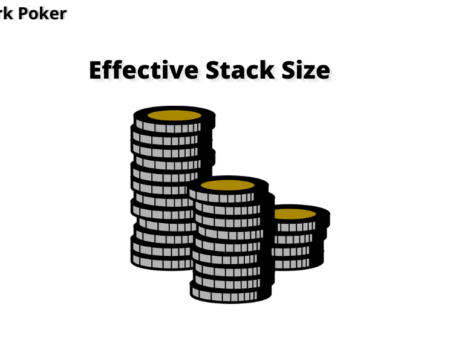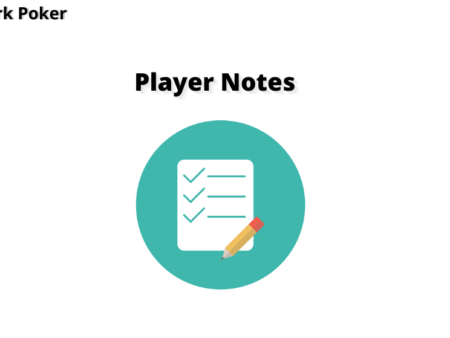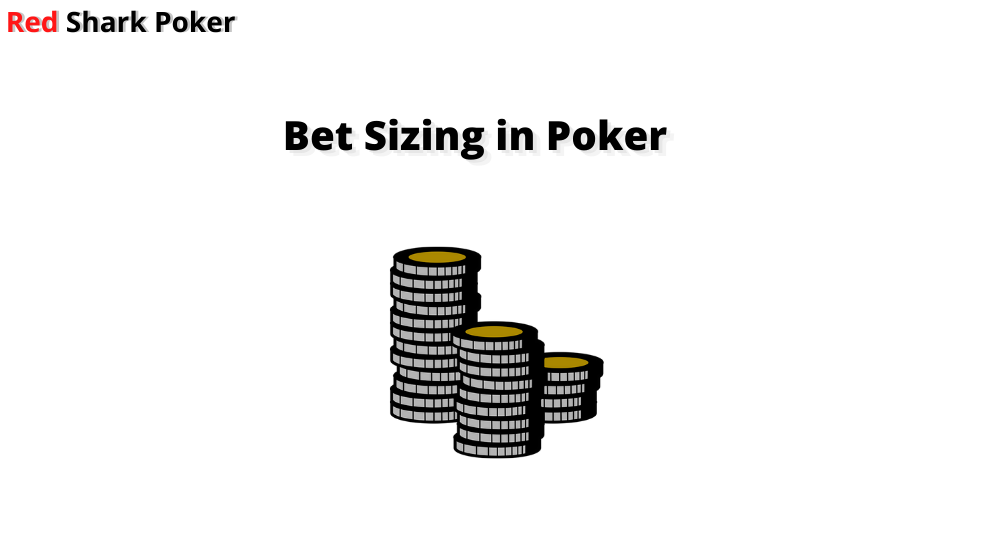
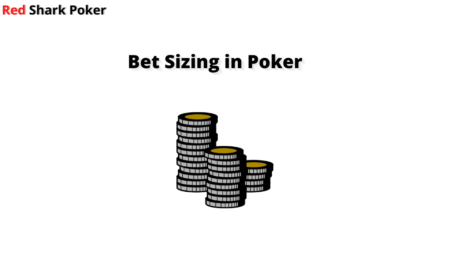
Before we delve into the topic of bet sizing in poker, let us understand your style of betting. You open-raise to 3X big blind ($30) with A♠ 5♥ from the Cutoff in a $5/$10 6-max online game. The button and the big blind call. The pot is now $105. The flop reads A♦ 9♣ 7♠. You have a top pair! How much will you bet here? Which bet button will you hit?
- Hit the 2X button and bet $20 (2X bb)
- Hit the 3X button and bet $30 (3X bb)
- Hit the 5X button and bet $50 (5X bb)
bb = Big Blind
If you are hitting all those X buttons, you have a big leak in your game! Your whole bet sizing in poker is wrong! Hit those X buttons only during preflop betting. Any post-flop bet size should always be in relation to the current pot size. So, the right bet sizing options on the flop (current pot = $105) should be:
| Bet Size | Bet Amount $ |
| Bet 1/4 of the pot (25% of the pot) | $26.25 |
| Bet 1/3 of the pot (33% of the pot) | $34.65 |
| Bet 1/2 of the pot (50% of the pot) | $52.5 |
| Bet 2/3 of the pot (66% of the pot) | $69.3 |
| Bet 3/4 of the pot (75% of the pot) | $78.75 |
| Bet the full pot (100% of the pot) | $105 |
| Overbet (More than 100% of the pot) | More than $105 |
You don’t have to calculate the percentage of the pot all the time. Most of the top online poker sites have 1/2 Pot, 3/4 Pot and Full Pot buttons in their games.
Why the Bet Size Should be in Relation to the Current Pot Size?
Before you bet, think of what kind of pot odds will your opponent get with your bet size. You should always give tough pot odds to your opponent so that they fold even with draws. In case they call, your poker bet size should give them incorrect pot odds.
The golden rule is that the equity should be greater than the pot odds. When the equity is greater than the pot odds, you will be winning more money than losing in the long run. When the pot odds are greater than the equity, you will be losing more money in the long run.
So, your bet size should give tough pot odds to your opponent. Opponent’s pot odds should be greater than his hand equity. When your opponent calls with incorrect pot odds, he will be losing money, and you will be winning money in the long run!
Your opponent’s pot odds are directly related to the size of your bet. Look at the poker bet sizing chart below and memorize the corresponding pot odds.
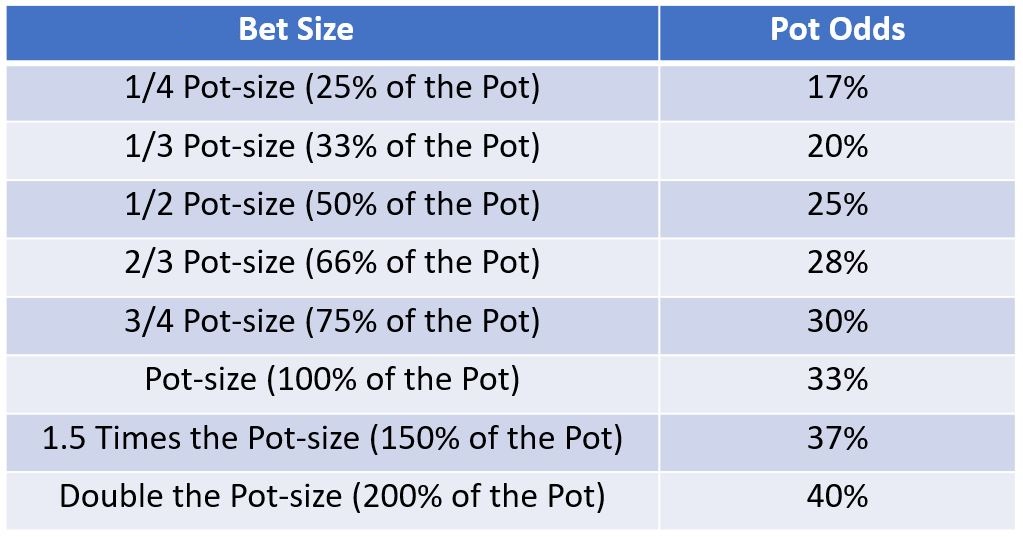
If you don’t know what pot odds are, read this chapter: Introduction to Poker Pot Odds
Let’s look concept of the bet sizing with an example. You open-raise to $30 (3X bb) with A♥ 2♥ from Middle Position in a $5/$10 6-max game. Both the Cutoff and the Button call. The pot is now $105. The flop reads A♦ 5♣ 6♠.
You have a top pair, but what should be your bet size in poker? Let’s review the situation in a logical manner to determine the bet size:
- You believe that you have the best hand. So, you should definitely bet for value.
- Your bet size should force one of the opponents to fold so that you can go heads up.
- The flop has 5♣ 6♠. Both the opponents are in late positions and any of them could be holding 78 (off or suited) that gives them an open-ended straight draw. Also, if any of them has a 89 (off or suited), they have a gutshot straight draw.
- Your bet size should give incorrect pot odds to your opponent who has a straight draw.
- If an opponent has an open-ended straight, he has 8 outs. His equity on the flop waiting for the turn is 32% (8 outs X 4).
- So, your bet size should give more than 32% pot odds to your opponent.
- If your opponent calls with the incorrect pot odds, you will be winning money.
According to the chart above, a full pot-size bet (100% of the pot) will give tough pot odds of 33% to your opponent. So, the right poker bet size should be $105. With this bet size, there can be two outcomes:
- Both the opponents fold and you win the pot of $105
- One opponent calls, which means either of two things:
- He is chasing his draws with incorrect pot odds
- He has a set (AA, 55 or 66) or Two Pairs (A5, A6 or 56)
When an opponent calls such a big bet, you can clearly pinpoint his range: 78, 89, AA, 55, 66, A5, A6, 56.
- It is less likely for your opponent to hold an Ace as you have an Ace and the board has another Ace. So, you can remove the possibility of your opponent holding an Ace.
- If we remove the Ace from his range, the possible hands in his range are: 78, 89, 55, 66, 56.
- It is now more clear that your opponent is most likely to be chasing his draws.
So, if the opponent continues to chase his draw with incorrect pot odds and misses to complete his draw by the river, you will be winning a big pot. Also, you will be cautious of a possible set or two pair.
Things to Remember
- Your Bet Size Dictates Your Opponent’s Pot Odds
- Opponent’s Pot Odds Should be Greater than His Equity
If you don’t know how to calculate equity, read this chapter: How to Calculate Poker Equity?
What is the Standard Poker Bet Size?
As we have discussed, your bet size should give tough pot odds to your opponent if he has a drawing hand. When his pot odds are more than his equity, he may fold his hand. In case he calls, he will call with incorrect pot odds which will benefit you.
Standard Preflop Bet Sizing in Poker
The standard preflop bet sizing is usually around 3X to 4X the size of the big blind. However, this size can change according to your position, hand strength and the type of opponents you are up against. If you are seated among many fish (loose-passive players), you can raise up to 10X to isolate a single fish and go heads up.
Against Multiple Limpers
If you bet below 3X bb, players who have already limped before you will just call your bet, and the pot will go multi-way. If multiple limpers have already entered the pot before your turn and you decide to bet, you should add an extra bet (1 bb) to your 3X bb raise.
Preflop Bet Size with Limpers = 3X bb + 1 bb
For example, if you are playing in a $5/$10 6-max game and there is already one limper in the pot, your bet should be $40 ($30 + $10).
Standard Post-flop Bet Sizing in Poker
Poker has become a very competitive sport in the last decade. Players tend to play more aggressively and bet a lot; so, the standard bet sizing in poker has increased substantially.
The standard post-flop bet size is between a 3/4 pot to a full pot.
Such bet sizing in poker gives incorrect pot odds to your opponent to continue with a drawing hand. And, you get a lot of value if your opponent calls with worse hands. However, before you decide to bet, always know the reasons for betting. Are you betting for value? Or, are you betting as a bluff?
Read: Reasons for Betting in Poker
Why Should You Bet Big?
The biggest beginner’s mistake is betting small when they don’t hit anything and betting big when they connect. This makes your play so predictable. Most of the beginners raise 3X bb before the flop and continue betting the same 3X bb bet size post-flop. If they don’t connect on the flop, they make the minimum bet and increase their bet size when they connect. So, stop making these ridiculous bet sizes and bet strong or don’t bet at all!
Benefit from Value Betting: When you believe that you have the best hand, you can extract a lot of value from your opponent. When your standard bet size is 3/4 of the pot, your opponent won’t be able to figure out if you are value betting or bluffing. When you have the best hand, you will get great value with your standard 3/4 pot size bet.
Avoid Bet Sizing Tells: Changing your bet sizing can reveal a lot about your situation. If you change from a big bet size to a smaller bet size, your opponent will have a good read on your hand strength. So, have a consistent big bet sizing to avoid giving off any tell.
When Should You Bet Small?
Scary Board: Although it is not advised to bet on a scary board, you can still bet a fraction of the pot if you can represent your range according to your position. For example, if you have A♦ K♠ from UTG on a flop like Q♦ Q♣ 2♠, you can bet small to get a quick fold from your opponent. A queen is well within your range, and you will risk less with a small bet.
Setting up a trap: If you hit the nuts post-flop, you can disguise your hand and check or bet small to allow your opponent to make a bluff raise or give him a chance to improve his hand on the later street. For example, if you have J♦ T♠ on a flop like J♣ J♠ T♣, you can bet small to allow your opponent to improve his hand to a flush. If he completes his draw, you can extract a lot of value.
Conclusion
Bet sizing reveals a lot about your skillset and your type of playing style. Be aggressive in your bet sizing in poker to avoid any leaks in your game. A consistent big bet sizing always helps in the long run, and you command a lot of respect from your opponent. Never click on the X bet buttons when betting on the post-flop and always size your bet in relation to the pot. Don’t let your opponent know that you are a fish at the table but make them fear of playing with a dangerous shark!

